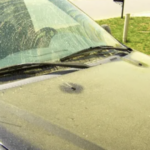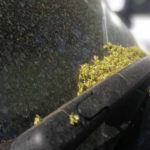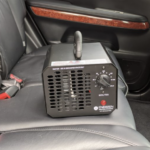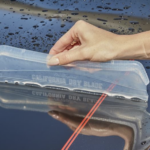The Best Methods for Removing Stubborn Stains from Car Upholstery
Why Car Upholstery Stains Are Hard to Remove
Car seats and carpets absorb liquids quickly, making stains harder to remove than on household fabrics. Once a spill dries, it bonds to the fibers, often leaving behind a discolored or sticky residue.
Common causes of stains include:
- Coffee, soda, and juice spills
- Grease or oil from food and hands
- Mud, dirt, and grass stains
- Ink, makeup, and dye transfer from clothing
- Pet accidents and odors
If not treated properly, stains can set into fabric or leather, requiring deep cleaning or even professional detailing.
Best Stain Removal Methods for Different Upholstery Types
Fabric Seats and Carpet Stains
Fabric upholstery absorbs spills more easily than leather or vinyl, making fast treatment essential.
1. Blot, Don’t Rub
- Use a clean microfiber towel to blot up as much liquid as possible.
- Avoid scrubbing, as this pushes the stain deeper into the fabric.
2. Use a Mild Cleaning Solution
- Mix one part white vinegar with two parts warm water.
- Add a small amount of dish soap for extra cleaning power.
- Spray the mixture onto the stain and let it sit for five minutes.
3. Scrub with a Soft Brush
- Use a soft-bristle brush or an old toothbrush to work the cleaner into the fibers.
- Scrub gently in circular motions to lift the stain.
4. Blot Again and Let Dry
- Wipe with a dry microfiber towel.
- Allow the area to air dry completely before sitting on the seat.
If stains remain, repeating the process or using a fabric cleaner with an enzyme-based formula may be necessary.
Leather Seats
Leather requires a different approach to avoid damaging the finish or drying out the material.
1. Wipe Up Spills Immediately
- Use a damp microfiber cloth to clean fresh stains.
- Avoid using excess water, as it can stain leather.
2. Use a Leather Cleaner or DIY Solution
- Mix equal parts water and white vinegar in a spray bottle.
- Spray lightly onto the stain and wipe gently with a microfiber cloth.
For grease stains, sprinkle a small amount of baking soda or cornstarch onto the affected area. Let it sit for a few hours to absorb the oil, then wipe clean.
3. Condition the Leather
- After cleaning, apply a leather conditioner to restore moisture and prevent cracks.
Vinyl or Synthetic Upholstery
Vinyl is more stain-resistant than fabric or leather but still requires proper cleaning to avoid discoloration.
1. Use a Gentle All-Purpose Cleaner
- Spray a mild cleaner or diluted dish soap solution onto the stain.
- Let it sit for a minute before wiping with a microfiber cloth.
2. Avoid Harsh Chemicals
- Never use bleach, ammonia, or acetone, as they can dry out or discolor vinyl.
3. Use a Magic Eraser for Tough Stains
- Lightly scrub stains with a melamine foam eraser, but avoid excessive pressure to prevent wear.
How to Remove Specific Types of Stains
Coffee and Soda Stains
- Blot with a dry towel immediately.
- Mix one part vinegar with two parts water and spray onto the stain.
- Scrub with a soft brush and blot dry.
Grease and Oil Stains
- Sprinkle baking soda or cornstarch on the stain and let it sit for a few hours.
- Vacuum up the powder and wipe with a damp cloth.
Mud and Dirt Stains
- Let the mud dry before brushing it off.
- Vacuum the area, then clean with a fabric cleaner or mild soap solution.
Ink Stains
- Dab with rubbing alcohol or nail polish remover on a cotton ball.
- Gently blot (don’t rub) until the stain lifts.
Pet Accidents and Odors
- Use an enzyme-based cleaner to break down urine or pet-related stains.
- Blot excess liquid and scrub with a soft brush before letting it air dry.
Preventing Future Stains
Apply Fabric or Leather Protectant
- A fabric protector spray repels spills and prevents stains from setting.
- For leather, a UV-protectant conditioner helps resist discoloration.
Use Seat Covers and Floor Mats
- Washable seat covers protect against food and drink spills.
- Rubber floor mats prevent dirt and moisture from soaking into carpets.
Clean Spills Immediately
- The faster a stain is treated, the easier it is to remove.
When to Seek Professional Detailing
If stains are deeply embedded or the upholstery has developed odors, professional cleaning may be necessary. Professional detailers use:
- Steam cleaning to remove tough fabric stains.
- Deep extraction methods to lift dirt from carpets and seats.
- Specialized leather treatments for restoring stained or faded leather.
For cars with frequent spills, a full interior detailing every 6-12 months helps maintain cleanliness.
Final Thoughts
Stains are inevitable, but with the right techniques, they don’t have to ruin your car’s interior. Whether dealing with fabric, leather, or vinyl, using the correct cleaning method ensures a spotless and well-maintained appearance.
With regular care and protective measures, keeping a clean interior is much easier, making every drive more enjoyable.
Leave a Comment Cancel Comment
Book Orlando Mobile Detailing
Search
Latest Post
-
 The Cost of Neglect: Why Regular Aircraft Detailing Saves Money in the Long Run
February 14, 2025
The Cost of Neglect: Why Regular Aircraft Detailing Saves Money in the Long Run
February 14, 2025
-
 Why Car Washes Aren’t Enough to Combat Pollen Damage
February 13, 2025
Why Car Washes Aren’t Enough to Combat Pollen Damage
February 13, 2025
-
 Orlando’s Pollen Problem: When Is It the Worst and How It Affects Your Car
February 13, 2025
Orlando’s Pollen Problem: When Is It the Worst and How It Affects Your Car
February 13, 2025
-
 How Ozone Generators Eliminate Stubborn Car Odors in Orlando
February 12, 2025
How Ozone Generators Eliminate Stubborn Car Odors in Orlando
February 12, 2025
-
 Why a Water Blade and Chamois Beat Towels Every Time!
February 9, 2025
Why a Water Blade and Chamois Beat Towels Every Time!
February 9, 2025
